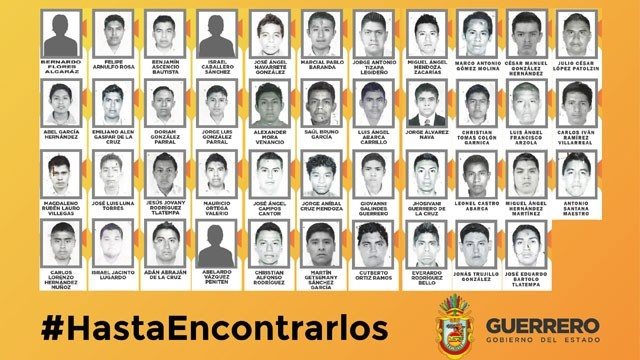It’s not that the United States isn’t paying attention to the tragedy unfolding in Mexico, it’s that we’re only interested in one narrative—the narco narrative. We like narcos in our movies and in our headlines. We like them in Mexico, where they belong, with their outlandish nicknames, their pet tigers and their armored cars. We like to keep them at a distance, to make sure they are barbaric figures, because they provide us with an easy scapegoat. Rather than thinking about the role of our drug consumption and drug war politics on violence in Mexico, we can blame the narcos.
This week the mainstream U.S. media taught us that narcos cut up the 43 disappeared Mexican students and burned their bodies on a pile of trash. That is the story that is easiest for us to understand, the one we like the most, and we like it because we can be outraged and then ignore it. We are not responsible for narcos, those inhuman assassins. And we don’t want to be responsible—not for the violence, not for the Mexican citizens who cross our borders fleeing it, not for our endless and well-documented drug consumption.
It is interesting how this logic works, the idea that narcos, drugs and drug money have corrupted Mexico, but somehow, the U.S. remains untainted. Where are all the American narcos? Banks accept their money, but they remain in business. Politicians take their donations, but they remain nameless. In fact, drug money saved the U.S. from an even deeper recession in 2008. Our well-oiled capitalist system is kept moving by narcos and their drug money.
The 43 disappeared students in Mexico represent a tipping point for the country. They lay bare the farce of President Enrique Peña Nieto’s policies of decreasing violence by refusing to acknowledge homicide, kidnapping and extortion statistics. In its search to find the missing students, his government discovered several mass graves, and each time they declared that the bodies of the missing were there, only to later announce that the graves contained other bodies. The government and media also called the students “radical” and insinuated that they might have been involved in gangs.
This strategy of accusing all victims of being criminals took shape during the 2006-2012 reign of President Felipe Calderón. He gave a famous speech in which he compared Mexico to a house full of cockroaches, and he defined it as the job of his administration to kill them. During his December 14, 2011 speech at the navy headquarters, he reported proudly, “I also see, with satisfaction, that we have done it, with successes and mistakes, and that we will leave, for those who come after us, a much cleaner house, a much more secure house, and a house that is worthy of being inhabited by Mexicans. And this will be an effort that we must undertake and one that we couldn’t do without you and without the army.”
Peña Nieto has continued Calderón’s policies of dehumanizing victims of violence, a tactic that places the blame for crime on victims and allows the state to shirk any duty of investigation. By insinuating that victims are narcos, are involved in the drug trade, or are gang members, the government has educated citizens to assume that those who experience violence are guilty of something. As Mexican writer Mario Bellatin explained when I interviewed him in 2012 on the eve of Peña Nieto’s inauguration, “In recent years, the government has tried to criminalize all the victims, to say that aside from being killed, they were delinquents, which is the ultimate strategy, as if to say, it’s good that they died because they were involved in some type of illicit activity.”
The U.S. media has been complicit in this storyline, often parroting what Mexican officials announce regardless of the lack of supporting evidence. In honor of the 43 missing students, the hundreds of thousands gone missing over the past decade, and those who enter our country each day fleeing violence, we need to have a more nuanced discussion, one that acknowledges the U.S. role in Mexico and holds it responsible for being a part of the solution.
***
Dr. Alice Driver is the author of More or Less Dead: Feminicide, Haunting, and the Ethics of Representation in Mexico (University of Arizona Press 2015). She recently translated Abecedario de Juárez, a collaboration between journalist Julián Cardona and artist Alice Leora Briggs that explores and maps the new language of violence in Mexico.





Alice Driver said: “Peña Nieto has continued Calderón’s policies of dehumanizing victims of
violence, a tactic that places the blame for crime on victims and allows
the state to shirk any duty of investigation… ‘In recent years, the government has tried to criminalize all the victims, to say that aside from being killed, they were delinquents, which is the ultimate strategy, as if to say, it’s good that they died because they were involved in some type of illicit activity.’”
This was exactly what Calderón did to a group of teenagers who were massacred in Ciudad Juárez.
In this video the mother of one of the teenage victims can be seen confronting the ex-president for his viscious and unconscionable slandering of her son:
AQUI NO ERES BIENVENIDO!! LE DICE A CALDERON MADRE DE ESTUDIANTES MASACRADOS
https://www.youtube.com/watch?v=5wwyjdhU7vk
Alleging the normalistas were involved with the narcos was the first propaganda trick employed by Team Peña Nieto against the normalistas, as can be seen in this article from Reforma. Now that that backfired, Team Peña Nieto is trying to stigmatize the normalistas as being an extremely violent group of left-wing political dissidents.